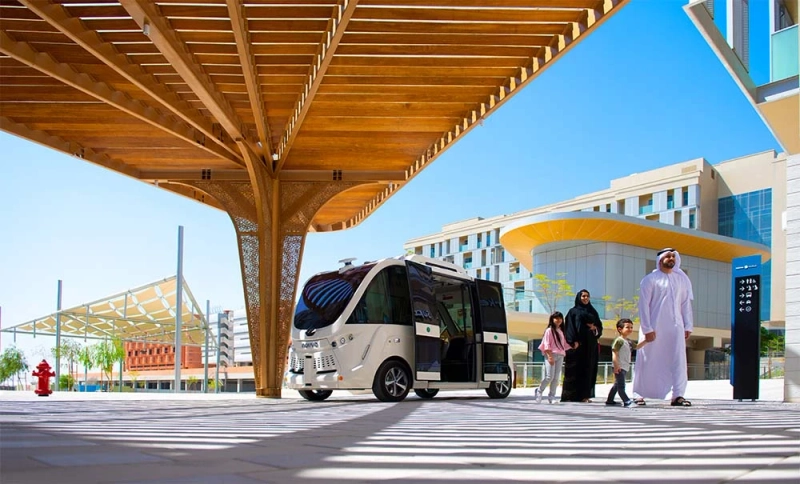As urban centers face mounting challenges—such as congestion, pollution, and climate change—the need for reimagined mobility systems is urgent. Masdar City in Abu Dhabi exemplifies how a city can integrate smart, sustainable transport at its core, blending innovation with environmental responsibility.
A Vision Grounded in Sustainability and Innovation
Masdar City, initiated in 2006 and launched in 2010, was purpose-built as a testbed for low-carbon, people-first urban design. Its comprehensive master plan incorporates renewable energy, resource-efficient buildings, circular water and waste systems, and a multimodal transport ecosystem that is built around accessibility, efficiency, and long-term sustainability.
Masdar City has taken a systems-thinking approach to Smart and Sustainable Mobility. This means creating a transport network that is not only environmentally sound but also user-friendly, technologically advanced, and scalable. The city’s transport infrastructure is a central part of this holistic vision, prioritizing walkability, electric transport, and autonomous mobility, all underpinned by smart technologies and real-time data integration.
Core Pillars of the Transport Network
Masdar City’s mobility strategy stands firmly on four foundational pillars:
- Low‑carbon transport infrastructure that emphasizes zero-emission vehicles and clean-energy solutions.
- Digital integration enables data-driven decisions, optimizes traffic flows, and improves user experience.
- Inclusive, walkable urban design that puts people—not cars—at the center of the city layout.
- Continuous innovation in mobility solutions, using the city as a living lab for new technologies and transport models.
Flagship Mobility Systems
1. Personal Rapid Transit (PRT)
Launched in November 2010, the electric, autonomous PRT system is a defining element of Masdar City’s mobility plan. It connects the North Car Park to the central district through a 1.4-kilometer underground track. In its first six years of operation, the system carried more than 2 million passengers and logged approximately 890,000 kilometers. It achieved remarkable operational efficiency, maintaining 99.6% system reliability and 99.9% vehicle reliability, with zero reported accidents.
The PRT system illustrates how automated, on-demand, last-mile transportation can be integrated safely into urban environments. With its quiet electric operation and consistent performance, it plays a key role in reducing dependence on private vehicles within the city.
2. Autonomous Electric Shuttles
In 2018, Masdar City became the first in the MENA region to deploy NAVYA autonomous electric shuttles. These 12-passenger vehicles operate at speeds of up to 25 km/h and are built to handle extreme weather conditions. They use a combination of GPS, lidar, V2X communication, and onboard sensors for safe navigation through the city.
These autonomous shuttles provide essential last-mile connectivity, bridging gaps between key zones such as residential areas, office buildings, and public spaces. They help reduce traffic congestion, promote shared mobility, and represent an important step toward scalable, driverless transit.
3. Active and Shared Mobility
Masdar City’s elevated, car-free podium level creates a pedestrian-friendly environment, with shaded walkways and dedicated cycling lanes that support healthy and sustainable commuting. The city also offers shared micromobility services, including e-bikes and e-scooters, encouraging short, low-impact trips across the compact urban grid.
This active mobility infrastructure not only reduces emissions but also enhances public health and social interaction, making sustainable transport a natural and convenient choice for residents and visitors alike.
4. Intelligent, Data-Driven Management
Masdar City incorporates smart infrastructure powered by Internet of Things (IoT) sensors and real-time analytics. These tools optimize fleet operations, energy usage, and routing decisions. For example, shuttle and PRT routes are continually monitored and adjusted based on user patterns and traffic data.
The use of intelligent systems improves service quality, enables predictive maintenance, and ensures that mobility resources are used as efficiently as possible. Even as full-scale data networks evolve, targeted applications are already delivering measurable benefits.
Research, Innovation & Collaboration
Masdar City operates as a real-world research platform where universities, global technology firms, and startups collaborate on sustainable mobility solutions. Real-time data from transport systems like the PRT and autonomous shuttles are used in research on next-generation batteries, vehicle-to-infrastructure (V2I) communication, AI-driven traffic systems, and autonomous navigation.
This collaborative ecosystem fosters continuous innovation and supports the development of solutions that extend beyond Masdar City itself, contributing to broader knowledge in sustainable urban transport.
Environmental, Social & Economic Benefits
Masdar City’s transport approach delivers tangible benefits across multiple dimensions:
- Decarbonization: The all-electric, zero-emission transport fleet reduces CO₂ emissions and contributes to cleaner air.
- Resource Efficiency: Compact, walkable neighborhoods and car-free zones reduce land usage and conserve water and energy.
- Livability: Easy access to reliable and sustainable mobility improves connections to education, employment, and services, supporting inclusive growth.
- Economic Growth: The city attracts clean-tech companies, R&D initiatives, and mobility startups, creating jobs and contributing to economic resilience and innovation.
A Scalable, Global Model
Masdar City’s transport model is designed to be adaptable and scalable. Through partnerships, international delegations, and knowledge-sharing initiatives, it plays an active role in shaping sustainable mobility policy and best practices.
By aligning with national and international climate goals—such as the UAE’s Net Zero 2050 strategy and key UN Sustainable Development Goals—Masdar City offers a compelling example for cities around the world facing similar urban mobility challenges.
The Road Ahead
Looking to the future, Masdar City plans to build upon its current momentum. Upcoming developments include:
- Expansion of autonomous vehicle fleets
- Enhancement of EV charging infrastructure
- Deployment of Mobility-as-a-Service (MaaS) platforms
- Integration of AI and digital twins for transport planning
- Exploration of electric vertical takeoff and landing (eVTOL) technologies
These initiatives will further strengthen the city’s position as a leader in clean, smart, and user-focused urban mobility.
Conclusion
Masdar City proves that smart, sustainable mobility is not a distant vision—it is already being implemented. By embedding innovation, digital systems, and environmental stewardship into its transportation infrastructure, the city sets a practical benchmark for low-carbon urban transit. For cities seeking cleaner, more resilient, and more livable futures, Masdar City’s model offers not just inspiration but real-world proof of what is possible.

